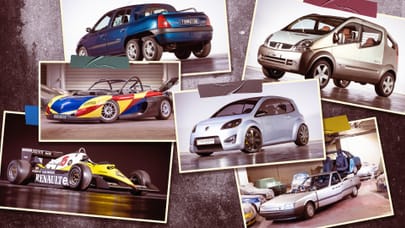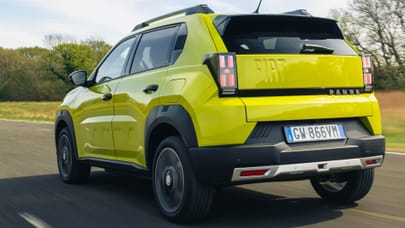
Ford Fiesta ST: TG mag's Hot Hatch of the Year
To see where you're going, you need to know where you've been. Time to meet the parents


Is this just what cars were like in the Eighties? I’ve no idea, mostly because I wasn’t there, but I refuse to believe brakes were this ineffective. I mean, how did anyone make it through the decade intact?
The XR2 must have brakes of some form hidden behind those pepper-pot wheels, I reason. That’s what I’m hoping, anyway, as I all but push the middle pedal through the flimsy bulkhead trying to avoid an Uber driver who’s decided, quite unreasonably, to effectively do an emergency stop in the middle lane of the A13.
Photography: Mark Riccioni
Advertisement - Page continues below
Disaster avoided and Uber chap duly chastised, time to focus on the car, and begin our potted history of fast Fiestas. This isn’t a MkI XR2. Ford doesn’t have one of those squirrelled away in its Heritage Collection, which nonetheless (more than) fills an innocuous, leaky, sizeable warehouse in deepest Dagenham. It does have two of these MkIIs, though.
And that’s an achievement because, like the Peugeot 205 GTI, Volkswagen Golf GTI, Renault 5 Turbo and so on, finding XR2s that haven’t been tastelessly modified/nicked/rolled/all of the above is nigh-on impossible nowadays. And the ones that are out there are starting to command big money. Well, relatively speaking.

The MkI XR2 was a funny little car. Pretty, in a way the MkII just isn’t, and the Fiesta wouldn’t be for another twentysomething years, and by modern standards really quite slow. It would do 100mph, though – just about – thanks to a development of Ford’s 1.6-litre “Kent” carburetted four-cylinder engine that gave 83bhp and 92lb ft. Ford claimed 0–60mph in 9.3 seconds and a sub-800kg kerbweight, and all for the early-Eighties equivalent of some £17k.
After just a couple of years on sale, that pretty little thing became this – the MkII XR2. Still carburetted, right up until it was canned in 1989, the MkII made a smidge more power than its predecessor. And had a 5spd manual to the old car’s 4spd. But because it weighed an extra 50kg, no doubt in part due to all that Essex-spec bodywork, it wasn’t really any faster.
Advertisement - Page continues below
It’s fair to say that time has not been as kind to the XR2 as it has to its contemporaries. While the Golf GTI and 205 GTI have soared in value and are routinely heralded as all-time hot-hatch greats, the Fiesta… hasn’t and isn’t. It’s not a high-quality item like the Golf, it doesn’t drive with the panache of the Peugeot and its image is, well, questionable at best. But that’s not to say it isn’t fun in its own way.
Like an old Mercedes G63 or an Abarth 500, it’s a car that isn’t objectively brilliant to drive, but nonetheless paints a wry smile on your face as you wrestle it along. Once you get past the old car tropes – the largely decorative brake pedal, the unassisted steering, spindle-thin A-pillars and Styrofoam dashboard to name but four – you’re left with a fizzy, happy thing you can’t help but enjoy.

Sadly, the same cannot be said of the XR2’s replacement, the, erm… XR2. Now with added fuel injection, the MkIII XR2i arrived in 1989. And people liked it, though we struggle to see why. The 205 GTI was still faster, more fun and more sophisticated, and it wasn’t saddled with the Ford’s seedy image. While the peppy Eighties XR2 offset its dynamic deficiencies with charm, the MkIII of the early Nineties couldn’t quite manage the same. It was just rubbish. Contemporary reviews derided its steering, chassis and engine. Things got worse with the wayward RS Turbo in 1990, but that only lasted for a couple of years before it was replaced by the 1.8-litre Zetec-engined RS1800. While that was a much better car for all kinds of reasons, it’s still not one that’s gone down in history as a great Fast Ford.
Which may or may not be why the Blue Oval decided to take a break from overly sporty Fiestas for a bit, once it killed off the MkIII in 1997. Instead of doing an XR version of the MkIV or MkV, it took the platform, stuck it under a pretty, two-door coupe body and gave it a new name: Puma. There were fast-ish Fiestas in that time, but it was the Puma that did the heavy lifting, and did it well. Nowadays you can get one for pennies. And you should, because they’re brilliant.

It was 2005 when we got our first Fiesta ST – our first proper ST full stop, actually. The first car from Team RS – the division within Ford that would later go on to engineer the Focus ST and RS – was among the last naturally aspirated hot hatches. And it was good enough, without ever being truly great. See, like the MkI and MkII XR2s from all those years ago, the MkVI Fiesta’s biggest problem was its competitors. This time, it wasn’t VW and Peugeot raining on Ford’s parade, but Renault with the RenaultSport Clio. It wasn’t the object the Ford was, but it was much better to drive. And because Ford was relying on the ST’s chassis, not outright power, to win it fans, that the Clio was better was quite inconvenient.
Now we’re well into the Noughties, and Ford is yet to make a properly great fast Fiesta. But don’t fret, because that’s about to change in fairly dramatic fashion.

See, the MkVI’s demise once more preceded an extended hiatus for the fast Fiesta – the MkVII landed in 2008, but the ST didn’t emerge until five years later, in 2013. And it was superb. Everyone thought so. We named it Car of The Year, and some 25,000 of you went out and spent actual money on one.
The reasons for its success are manyfold. First, it was genuinely brilliant. A better car than all its rivals. If until now Ford had been building decent hot hatches, only to come unstuck when a competitor released a truly excellent one, now things were the other way around. The Clio RenaultSport had its problems, the Polo was tedious and, though brilliant, the Peugeot 208 GTI you really wanted was several grand more expensive. That’s the second thing: not only was the ST better than all its rivals, but it was cheaper too. Much cheaper.
Advertisement - Page continues below
The ST was a car that was exactly as good as the sum of its parts, because they were all really good parts. Strong engine, good gearshift, the already amusing chassis of the regular Fiesta – it would have been harder for Ford to get it wrong than oh, so right.
By the standards of modern performance cars, the ST was brilliantly simple. A 1.6-litre turbocharged engine, no suspension or drive modes, a six-speed manual and no option of an auto, front-wheel drive, no trick exhaust… the list goes on. And it was all the better for it. Just look at how overcomplication compromised the Clio.

So when Ford announced the new ST was to get drive modes, a trick three-cylinder engine and much besides, instead of rubbing our hands together with glee, we crossed our fingers and prayed to the hot hatch gods it would be a worthy successor...
Advertisement - Page continues below
Trending this week
- Car Review
Porsche 911 GT3 (992.2)







